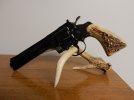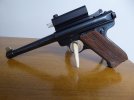Lee makes a tool to do a job , and it does the job .
Among others I really like the 358-158 RF , 358-200 , 312-155 , and 401-175 . The 35s offer about all you can want for . The 30/31 has shot well in everything I've put it in . I've had both an LBT and RCBS 40-175 RFs that gave nothing more that the Lee in 40 S&W did . During this shortage someone needed the others more than me .
At the end of the BO administration I did an amortization on lead , mould , dies , power , primers , checks and sizer for the 6.8SPCII at 1000 rounds . It came out $14/100 . I didn't include presses , pots , etc . That was with the fine 279-124 NOE 5C .
If we buy a box of 250 45/230 or 255s in cast or plated it costs or did about $40 and 35/125-158s are 500 for about the same price .
If I spend $38-55 on a Lee 6 cavity it's basically a break even , buying lead , for 1000-1500 bullets . Now if you're the sort that only shoots 100 rounds a year it's not worth the time to bother . If you shoot 50-100/month well now it's looking much better because next year it's only going to cost about $3-5/100 for the lead for the 45s and $2/100 for stuff in the 150 gr class .
If one gets good at manipulating alloy in pistols and even in moderate rifles there's really not a lot of terminal advantage in jackets over cast . It changes radically above about 2400 fps MV . I'm not implying the old cliche' anything you can do , I can do better . I'm just saying that with work a heavy for cartridge cast will do what the jacket does from a 165 gr 30-30 to a 200 gr 308 .
If we use cheap FMJ for a cost point then there's no contest in pay off of the moulds value . At $25/100 vs $18-50 mould and 1-3# per 100 in lead 500 bullets and your money ahead .
Like others I have Lee through H&G moulds and I can say with 100% confidence that while the 6C Lee cranks out a pile of of 452-255 RF I'd rather cast the slightly slower 454424 NOE 5C ...... except that that clever 3rd handle gets the edge . I guess that applies to all of the 6Cs on hand .
The difference between iron and even other aluminum 2 cavity moulds is not a contest really and until I bought the first NOE and had cast an RCBS for a while it wasn't so obvious as it is now .
Then I have the two .380 RB moulds and the 458-500 gifted and a 50 cal Minie' . Those 4 wreak of everything that is a Lee complaint .
The tangical cut off on the .380s was .368 , not a good thing in a 36 cal C&B with .375 cambers . The 50 cal Minie' is a whole chain of its own mysteries and not one of the 3 50 cal ML will take it for a 3rd field shot . It does have a neat base plug arrangement if the top band were just .002 smaller .....
The 458 500 5R suffers from too much bullet in not enough block . Among other things it's too long in the blocks , I would say design/engineering/planning error .
Lee tools are tools to do a job .
They do the job .
If you don't mind some fiddling , covered in the blanket "Leementing" expression , then their as good as any .
Moulds in specific ? I ran probably 5,000 cycles on an old Vbar 452-255 I have it still and it still works well . I have one of the new style that still requires the "Lee bump shuffle" to close and the old Vbar 325-170 that trained me on that is about used up at 1000 or so .
I've taken a dozen or so Lee moulds in that "I've done all the stuff and it just won't cast" and cast great bullets . I just run them too hot and too fast with a pot too hot and they work fine .
I hate having to fix a tool before I can use use it . I don't mind the prep on moulds but the less the better ......
When I have a new set of dies Lee's are the only one I have to disassemble and clean before I can use them . They also take about 3x the lube in steel dies before they settle down . Of course they can be polished and that was handy for a wildcat neck up ......
The presses . I've had 3 turrets and a Load Master , we just didn't click .
In the case of the turrets I think it's the lack of a cam stop that puts me off .
I won't go into the LM ....
No law against just filling up four or less cavities. I do it on occasion. Some of my molds are mixed cavities of GC and PB, based on what I want/need.
 The smaller stag stocks were purchased from Eagle grips for Cindy's smaller hands. I have the original walnuts and a set of presentation Pac's.................which I prefer for colder weather.
The smaller stag stocks were purchased from Eagle grips for Cindy's smaller hands. I have the original walnuts and a set of presentation Pac's.................which I prefer for colder weather.

